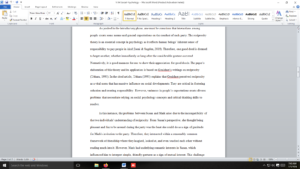Social psychology
Overview
This week, you will be writing a paper in which you apply theories and concepts from social psychology related to prosocial behavior, rejection, and close relationships. You will also be required to apply behavioral ethics and critical thinking concepts. Successful practitioners understand the dynamics of various relationships. Their understanding of that which affects a successful relationship enables them to support positive and loving relationships for their clients.
CASE STUDY- SUSAN: SOCIAL UP & DOWN – ATTACHED I HAVE SUBMITTED SUSAN CASE STUDY; THE SELECTED THEORY, BEHAVIORAL ETHICS & CRITICAL THINKING CONCEPTS EMBEDDED WITH SUSAN’S CASE STUDY
I HAVE ALSO ATTACHED THE SCORING GUIDE. APA STYLE WRITING & REFERENCES REQUIRED
Instructions
This week you will be writing a paper that includes the following:
- Summarize the case study.
- Describe credible and scholarly sources, relevant to a particular theory.
- Apply a social psychological theory to a chosen case study.
- Explain how social psychological research studies relate to a particular social psychological theory.
- Apply an ethical reasoning concept to a chosen case study.
- Apply a critical thinking concept to a chosen case study.
- Provide a conclusion.
- Create a text in the third person, adhering to conventions of academic tone.
- Demonstrate compliance with APA style, citation, and referencing guidelines
- Length: 4–5 double-spaced pages, in addition to the title page and reference page.
- Reciprocity: Mahmoodi, A., Bahrami, B., & Mehring, C. (2018). Reciprocity of social influence. Nature Communications, 9(1), 1–9
Requirements: 4-5 PAGES EXCLUDING TITLE & REF
i uploaded everything you will need but if you need anything else please let me know. I have attached the case study, the chosen 3 concepts and the scoring guide.
Answer preview
In this instance, the problems between Susan and Mark arise due to the incompatibility of the two individuals’ understanding of reciprocity. From Susan’s perspective, she thought being pleasant and fun to be around during the party was the least she could do as a sign of gratitude for Mark’s invitation to the party. Therefore, they interacted within a reasonably common framework of friendship where they laughed, looked at, and even touched each other without reading much into it. However, Mark had underlying romantic interests in Susan, which influenced him to interpret simple, friendly gestures as a sign of mutual interest. This challenge lays bare the diverse facets of reciprocity that define interpersonal relationships.
[1434 Words]

Social psychology

